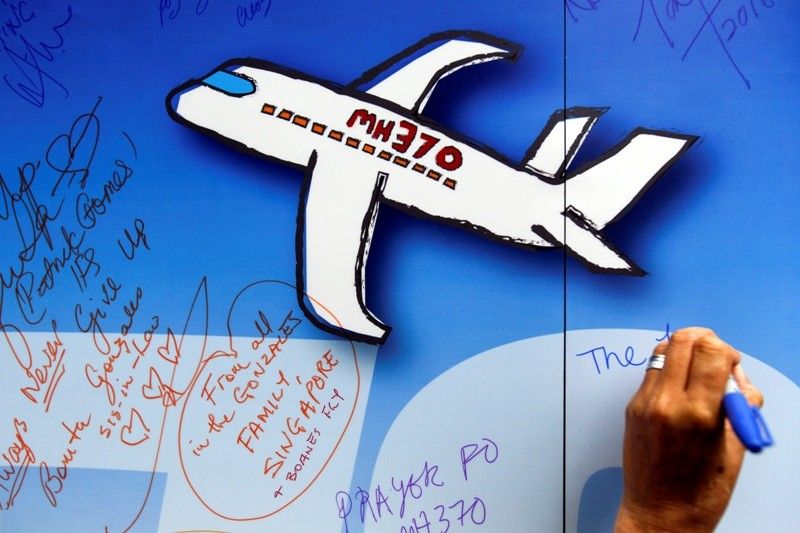Australia defends end of MH370 hunt; investigation continues

SYDNEY — Australia's Transport Minister Darren Chester said on Wednesday that experts will continue analyzing data and scrutinizing debris washing ashore from Malaysia Airlines Flight 370 in a bid to narrow down where it crashed in the southern Indian Ocean. But Chester declined to specify what kind of breakthrough would convince officials to resume the search for the missing airliner that was suspended this week after almost three fruitless years of searching.
"When we get some information or data or a breakthrough that leads us to a specific location, the experts will know it when they see it," he told reporters in the southern city of Melbourne.
The sonar seabed search ended on Tuesday, possibly forever — not because investigators have run out of leads, but because the countries involved in the expensive and vast deep-sea hunt have shown no appetite for opening another big phase.
Late last year, as ships with high-tech search equipment covered the last strips of the 120,000-square kilometer (46,000-square mile) search zone, experts concluded they had been looking in the wrong place and should have been searching a smaller area immediately to the north. But by then, $160 million had already been spent by Malaysia, Australia and China, who had agreed over the summer not to search elsewhere without pinpoint evidence. More than half of those aboard the plane were Chinese.
Since no technology currently exists that can tell investigators exactly where the plane is, that means the most expensive, complex search in aviation history is over, barring a change of heart from the three countries.
Chester defended the decision to call off the hunt without checking the new area to the north, saying, "No one is coming to me as minister and saying, 'We know where MH370 is.'" And he insisted the enormous cost had nothing to do with pulling the plug.
"It is a costly exercise, but it hasn't been the factor which led to the decision to suspend the search," Chester said. "We don't want to provide false hope to the families and friends. We need to have credible new evidence leading to a specific location before we would be reasonably considering future search efforts."
The new 25,000-square kilometer (9,700-square mile) area to the north was determined with the help of drift modeling by Australia's Commonwealth Scientific and Industrial Research Organization, which attempted to calculate where debris that has washed ashore on coastlines in the western Indian Ocean originated. Chester said that drift modeling would continue, and experts will scrutinize any further debris that washes up. Investigators will also continue to refine the satellite data that led officials to conclude the plane went down somewhere in the Indian Ocean.
Many relatives of those lost on the plane, which vanished on March 8, 2014, during a flight from Kuala Lumpur to Beijing, responded to the announcement that the search was over with outrage. A support group, Voice 370, issued a statement saying that extending the search is "an inescapable duty owed to the flying public."
Without understanding what happened to the plane, there's a "good chance that this could happen in the future," said K.S. Narendran, a member of the group.
Tony Abbott, who was Australia's prime minister when the Boeing 777 disappeared, expressed regret that the search had ended. Abbott pledged on the first anniversary of the tragedy: "It can't go on forever, but as long as there are reasonable leads, the search will go on." On Tuesday, he tweeted: "Disappointed that the search for MH370 has been called off. Especially if some experts think there are better places to look."
Chester said he understood Abbott's feelings, given his involvement in the early phases of the search.
"The experts who have been working on this project, this has consumed their life for the best part of three years. This is a disappointing and frustrating day for them as well," Chester said. "I understand that former Prime Minister Abbott has some concerns as well. He is entitled to express those opinions but it is not a decision that was reached lightly by the three governments in July last year and we remain open to further analysis of whatever data becomes available into the future."
There is the possibility that a private donor could offer to bankroll a new search, or that Malaysia will kick in fresh funds. But no one has stepped up yet, raising the bleak possibility that the world's greatest aviation mystery may never be solved.
Investigators have been stymied again and again in their efforts to find the aircraft. Hopes were repeatedly raised and smashed by false leads: Underwater signals wrongly thought to be emanating from the plane's black boxes. Possible debris fields that turned out to be sea trash. Oil slicks that contained no jet fuel. A large object detected on the seafloor that was just an old shipwreck.
In the absence of solid leads, investigators relied largely on an analysis of transmissions between the plane and a satellite to narrow down where in the world the jet ended up — a technique never previously used to find an aircraft.
Based on the transmissions, they narrowed down the possible crash zone to a vast arc of ocean slicing across the Southern Hemisphere. Even then, the search zone was enormous and located in one of the most remote patches of water on Earth — 1,800 kilometers (1,100 miles) off Australia's west coast. Much of the seabed had never even been mapped.
For years, search crews on several ships used sonar equipment to painstakingly comb the search area. The search zone shifted multiple times as investigators refined their analysis, all to no avail. Some began to question whether the plane had gone down in the Southern Hemisphere at all.
Then, in July 2015, came the first proof that the plane was indeed in the Indian Ocean: A wing flap from the aircraft was found on Reunion Island, east of Madagascar. More than 20 pieces of debris confirmed or believed likely to have come from the aircraft have since washed ashore. But while the debris proved the plane went down in the Indian Ocean, the location of the main underwater wreckage — and its crucial black box data recorders — remains stubbornly elusive.
If the plane is never found, the reasons for its disappearance and crash will probably never be known, though Malaysia has said the plane's erratic movements after takeoff were consistent with deliberate actions.
The sister of the pilot, Captain Zaharie Ahmad Shah, slammed authorities for ending the search without settling the mystery, saying her brother will never be absolved of suspicions he deliberately crashed the plane.
"How can they end the search like that? There will be finger-pointing again," Sakinab Shah said.
Chester said he had not given up hope that the plane may one day be found.
"It's an extraordinary aviation mystery as it stands today," he said. "I'm hopeful that we have a breakthrough in the future. We need to prepare ourselves for the sad and tragic reality that in this foreseeable future, we may not find MH370."
- Latest
- Trending

































